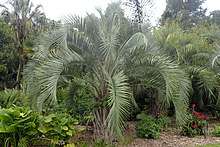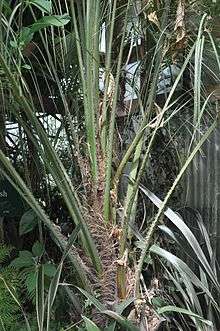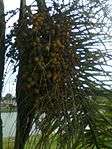Butia eriospatha
| Butia eriospatha | |
|---|---|
 | |
| Butia eriospatha in the Auckland Botanic Gardens. | |
| Scientific classification | |
| Kingdom: | Plantae |
| (unranked): | Angiosperms |
| (unranked): | Monocots |
| (unranked): | Commelinids |
| Order: | Arecales |
| Family: | Arecaceae |
| Subfamily: | Arecoideae |
| Tribe: | Cocoseae |
| Genus: | Butia |
| Species: | B. eriospatha |
| Binomial name | |
| Butia eriospatha | |
| Synonyms[2] | |
| |
Butia eriospatha is a small species of Butia palm endemic to the highlands of southern Brazil.[1] It is very similar to B. odorata, but is easily distinguished from this species by the distinct spathes which are densely covered in rust-coloured, woolly hairs.[3] Indeed, the specific epithet is derived from Greek ἔριον, wool, and Latin spatha, which refers to the spathe.[4] It has been given the name woolly jelly palm (UK) or wooly jelly palm (US) in English.[5] Vernacular names for it where it is native are butiá-da-serra,[6][7][8][9] butiázeiro,[7][8] butiá-veludo,[7] butiá[3][7] butiá verdadeiro,[8] butiá-do-campo,[8] yatáy[8] and macumá.[3][7]
Taxonomy
In 1970 Sidney Fredrick Glassman moved this species, along with all other Butia, to Syagrus,[10] but in 1979 he changed his mind and moved everything back.[11]
Description
Butia eriospatha is a solitary-trunked palm tree. The trunk is sometimes inclined to a side, and may occasionally be subterranean. The 20-22 pinnate leaves arch back down towards the trunk and have a petiole armed with teeth spaced along their margins; the rachis of the leaf is 150–220cm in length.[6][9] The branched inflorescence develops in a woody, 115–135cm long spathe covered in a dense woolly indumentum. The pistillate (female) flowers are 5–9mm in length. The shape of the fruit is globose (round), as is the shape of the nuts.[6]
Like all species of Butia studied, this species has relatively larger pollen grains than that of other genera of palm present in Rio Grande do Sul, Brazil. These grains are bilaterally symmetrical, prolate-spheroid, monosulcate, and with the end piriform (pear-shaped). The surface is covered in minute 2μm-large reticulate patterns.[9]
Distribution
It is native to southern Brazil, where the main bulk of its population is found straddling the highlands in the eastern Santa Catarina/Rio Grande do Sul border regions, surrounded by scattered sub-populations in the southeastern coastal part of the high plateau of the states of Paraná, Rio Grande do Sul, and Santa Catarina.[6][7] A naturalised population in an area of northern Misiones Province, Argentina, was reported in 2008.[12]
Bauermann et al. investigated the possibility of using palm pollen, including this species, in palynology, in order to try to provide more detail about the ancient changes in habitat in the state Rio Grande do Sul in Brazil by tracking the changes in distribution and abundance of the palms, but were unable to provide much detail on the subject.[9]
Habitat & ecology
It is found growing in the Atlantic rainforest biome on a plateau at higher altitudes, between 700 and 1,200m, where it is largely found in grasslands, aggregated in often extensive, dense, almost monoculture palm groves, but higher up also sometimes in open Araucaria forest.[1][6][12]
These distinctive dense palm groves are known as butiázais in Rio Grande do Sul,[12] but may also be known as butiatuba or butiazal.[9]
Uses
Butia eriospatha is reasonably available in Europe as an ornamental. It is often used in mild temperate climates as a hardy palm for its exotic look.
Products obtained from the palm are used locally and are not available in general commerce.[7] The fruit pulp is used as a base to make beverages.[8][13] A wine is made from the palm, as are juices and jellies/jams.[7]
Fibres were once harvested from this palm,[8] which were used to make mattresses. Plantations of this palm were planted in the 1950s in Brazil for this purpose.
Horticulture
It is sometimes cultivated in Brazil and Argentina.[8]
It is advised to plant the palms in full sunlight. It is said to take -14°C, but should be protected at -6°C in the Netherlands.[14]
Conservation
The species is widely cultivated, but according to Noblick in 1998, wild populations are declining.[1] It was listed as em perigo (endangered) by the Rio Grande do Sul state government in 2002 (decreto nº 42.099) and 2014 (decreto n° 52.109), because the population is believed to have been reduced by over 50% in at least the last 100 years.[12][15][16]
In 2012 the Centro Nacional de Conservação da Flora rated the conservation status for Brazil as 'vulnerable'.[7]
Gallery
 Note the teeth along the margins of the leaf petiole on this plant for sale in the USA.
Note the teeth along the margins of the leaf petiole on this plant for sale in the USA.- Young Butia eriospatha palm cultivated in the Jardín Botánico Canario Viera y Clavijo, flowering at the end of March.
- Flowers of B. eriospatha at the end of March at the Jardín Botánico Canario Viera y Clavijo.
 Ripe fruit in December (summer) in Brazil.
Ripe fruit in December (summer) in Brazil._(20692838501).jpg) Comparison of fruit by João Barbosa Rodrigues in 1901. B. eriospatha is 'D' (note the smaller, very round fruit); B. yatay is 'A', B. odorata is 'B' & 'C', and Syagrus coronata is 'E'.
Comparison of fruit by João Barbosa Rodrigues in 1901. B. eriospatha is 'D' (note the smaller, very round fruit); B. yatay is 'A', B. odorata is 'B' & 'C', and Syagrus coronata is 'E'.
References
- 1 2 3 4 Noblick, L. (1998). "Butia eriospatha". The IUCN Red List of Threatened Species. 1998: e.T38462A10114794. doi:10.2305/IUCN.UK.1998.RLTS.T38463A10120736.en. Retrieved 12 June 2016.
- ↑ Govaerts, R. (2018). "World Checklist of Selected Plant Families". Royal Botanic Gardens, Kew. Retrieved 25 September 2018.
- 1 2 3 Glassman, S. F. (1970). "A conspectus of the palm genus Butia Becc". Fieldiana. 32 (10): 145, 149. doi:10.5962/bhl.title.2384. Retrieved 25 September 2018.
- ↑ Soares, Kelen Pureza (2015). "Le genre Butia". Principes (in French). 1: 25. Retrieved 25 September 2018.
- ↑ Porcher, Michel H. (20 April 2003). "Sorting Butia names". Multilingual Multiscript Plant Name Database (MMPND). University of Melbourne. Retrieved 26 September 2018.
- 1 2 3 4 5 Heiden, G.; Ellert-Pereira, P.E.; Eslabão, M.P. (2015). "Brazilian Flora Checklist - Butia eriospatha (Mart. ex Drude) Becc". Butia in Lista de Espécies da Flora do Brasil, Flora do Brasil 2020 under construction (in Portuguese). Jardim Botânico do Rio de Janeiro. Retrieved 26 September 2018.
- 1 2 3 4 5 6 7 8 9 Prieto, Pablo Viany (29 June 2012). "Centro Nacional de Conservação da Flora - CNCFlora" (in Portuguese). Retrieved 26 September 2018.
- 1 2 3 4 5 6 7 8 Kruse, J. (April 2001). "Mansfeld's World Database of Agriculture and Horticultural Crops". IPK. Retrieved 26 September 2018.
- 1 2 3 4 5 Bauermann, Soraia Girardi; Evaldt, Andréia Cardoso Pacheco; Zanchin, Janaína Rosana; de Loreto Bordignon, Sergio Augusto (June 2010). "Diferenciação polínica de Butia, Euterpe, Geonoma, Syagrus e Thritrinax e implicações paleoecológicas de Arecaceae para o Rio Grande do Sul". Iheringia - Série Botânica (in Portuguese). 65 (1): 35–46. ISSN 0073-4705. Retrieved 11 October 2018.
- ↑ Glassman, Sidney Fredrick (1970). "A conspectus of the palm genus Butia Becc". Fieldiana. 32 (10): 145–149. doi:10.5962/bhl.title.2384. Retrieved 12 October 2018.
- ↑ Glassman, Sidney Fredrick (1979). "Re-evaluation of the Genus Butia With a Description of a New Species" (PDF). Principes. 23: 70–71. Retrieved 12 October 2018.
- 1 2 3 4 Soares, Kelen Pureza; Longhi, Solon Jonas; Neto, Leopoldo Witeck; de Assis, Lucas Coelho (2014). "Palmeiras (Arecaceae) no Rio Grande do Sul, Brasil". Rodriguésia - Revista do Jardim Botânico do Rio de Janeiro (in Portuguese). 65 (1): 121. Retrieved 22 September 2018.
- ↑ "Butia eriospatha". Germplasm Resources Information Network (GRIN). Agricultural Research Service (ARS), United States Department of Agriculture (USDA). Retrieved 2018-09-26.
- ↑ Wagelaar, Edwin (31 December 2017). "Het geslacht Butia". Palmexotica (in Dutch). Retrieved 3 October 2018.
- ↑ "Decreto n° 52.109/2014". Decreto 52.109, of 2014 (PDF) (in Portuguese).
- ↑ "Lista das Espécies Ameaçadas de Extinção no RS". Avaliação do Estado de Conservação de Espécies Flora - RS - 2014 (in Portuguese). FZB RS - Fundação Zoobotânica do Rio Grande do Sul. Retrieved 25 September 2018.
